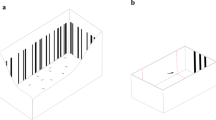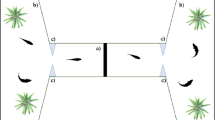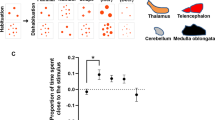Abstract
Several studies have investigated the ontogeny of the capacity to discriminate between discrete numerical information in human and non-human animals. Contrarily, less attention has been devoted to the development of the capacity to discriminate continuous quantities. Recently, we set up a fast procedure for screening continuous quantity abilities in adult individuals of an animal model in neurodevelopmental research, the zebrafish. Two different sized holes are presented in a wall that divides the home tank in two halves and the spontaneous preference of fish for passing through the larger hole is exploited to measure their discrimination ability. We tested zebrafish larvae in the first, second and third week of life varying the relative size of the smaller circle (0.60, 0.75, 0.86, 0.91 area ratio). We found that the number of passages increased across the age. The capacity to discriminate the larger hole decreased as the ratio between the areas increased. No difference in accuracy was found as a function of age. The accuracy of larval zebrafish almost overlaps that found in adults in a previous study, suggesting a limited role of maturation and experience on the ability to estimate areas in this species.



Similar content being viewed by others
Data availability
The data that support the findings of this study are available from the corresponding author upon request.
References
Agrillo C, Bisazza A (2014) Spontaneous versus trained numerical abilities: a comparison between the two main tools to study numerical competence in non-human animals. J Neurosci Meth 234:82–91
Agrillo C, Bisazza A (2018) Understanding the origin of number sense: a review of fish studies. Philos T R Soc B 373:20160511
Agrillo C, Piffer L, Adriano A (2013) Individual differences in non-symbolic numerical abilities predict mathematical achievements but contradict ATOM. Behav Brain Funct 9:26
Barabassy A, Beinhoff U, Riepe MW (2010) Cognitive estimation in aged patients with major depressive disorder. Psychiat Res 176:26–29
Barker AJ, Baier H (2015) Sensorimotor decision making in the zebrafish tectum. Curr Biol 25:2804–2814
Barry M, Shanas U, Brunton DH (2014) Year-round mixed-age shelter aggregations in Duvaucel's geckos (Hoplodactylus duvaucelii). Herpetologica 70:395–406
Beran MJ, Parrish AE (2016) Going for more: Discrete and continuous quantity judgments by nonhuman animals. In: Continuous issues in numerical cognition. Academic Press, pp 175–192
Bianco IH, Kampff AR, Engert F (2011) Prey capture behavior evoked by simple visual stimuli in larval zebrafish. Front Syst Neurosci 5:101
Bilotta J, Saszik S (2001) The zebrafish as a model visual system. Int J Dev Neurosci 19:621–629
Bisazza A, Manfredi S, Pilastro A (2000) Sexual competition, coercive mating and mate assessment in the one-sided livebearer, Jenynsia multidentata: are they predictive of sexual dimorphism? Ethology 106:961–978
Bisazza A, Piffer L, Serena G, Agrillo C (2010) Ontogeny of numerical abilities in fish. PLoS ONE 5:e15516
Brand M, Kalbe E, Fujiwara E, Huber M, Markowitsch HJ (2003) Cognitive estimation in patients with probable Alzheimer’s disease and alcoholic Korsakoff patients. Neuropsychologia 41:575–584
Brannon EM, Lutz D, Cordes S (2006) The development of area discrimination and its implications for number representation in infancy. Dev Sci 9:F59–F64
Brennan CH (2011) Zebrafish behavioural assays of translational relevance for the study of psychiatric disease. Rev Neurosci 22:37–48
Buckley CE, Goldsmith P, Franklin RJ (2008) Zebrafish myelination: a transparent model for remyelination? Dis Model Mech 1:221–228
Butterworth B, Reeve R, Reynolds F (2011) Using mental representations of space when words are unavailable: studies of enumeration and arithmetic in indigenous Australia. J Cross Cult Psychol 42:630–638
Colwill RM, Creton R (2011) Locomotor behaviors in zebrafish (Danio rerio) larvae. Behav Process 86:222–229
Cordes S, Brannon EM (2008) Quantitative competencies in infancy. Dev Sci 11:803–808
Ditz HM, Nieder A (2016) Numerosity representations in crows obey the Weber-Fechner law. Proc R S B Biol Sci 283(1827):20160083
Dosen LD, Montgomerie R (2004) Female size influences mate preferences of male guppies. Ethology 110:245–255
Eriksen CW, Hake HW (1955) Multidimensional stimulus differences and accuracy of discrimination. J Exp Psychol 50:153
Feigenson L (2007) The equality of quantity. Trends Cogn Sci 11(5):185–187
Feigenson L, Carey S, Spelke E (2002) Infants' discrimination of number vs continuous extent. Cognit Psychol 44:33–66
Fenson L, Dale PS, Reznick JS, Bates E, Thal DJ, Pethick SJ, Stiles J (1994) Variability in early communicative development. Monogr Soc Res Child 1:185
Fero K, Yokogawa T, Burgess HA (2011) The behavioral repertoire of larval zebrafish. Zebrafish models in neurobehavioral research. Humana Press, Totowa, New York, pp 249–291
Forsatkar MN, Safari O, Boiti C (2017) Effects of social isolation on growth, stress response, and immunity of zebrafish. Acta Etholog 20:255–261
Fuiman LA, Webb PW (1988) Ontogeny of routine swimming activity and performance in zebra danios (Teleostei: Cyprinidae). Anim Behav 36:250–261
Gandini D, Lemaire P, Michel BF (2009) Approximate quantification in young, healthy older adults’, and Alzheimer patients. Brain Cognition 70:53–61
Gazzola A, Vallortigara G, Pellitteri-Rosa D (2018) Continuous and discrete quantity discrimination in tortoises. Biol Lett 14:20180649
Girelli L, Luzzatti C, Annoni G, Vecchi T (1999) Progressive decline of numerical skills in Alzheimer-type dementia: a case study. Brain Cognition 40:132–136
Halberda J, Mazzocco MM, Feigenson L (2008) Individual differences in non-verbal number acuity correlate with maths achievement. Nature 455:665
Haug MF, Biehlmaier O, Mueller KP, Neuhauss SC (2010) Visual acuity in larval zebrafish: behavior and histology. Front Zool 7:8
Henik A (ed) (2016) Continuous issues in numerical cognition: how many or how much. Academic Press, Cambridge
Izard V, Sann C, Spelke ES, Streri A (2009) Newborn infants perceive abstract numbers. Proc Natl Acad Sci 106:10382–10385
Kalueff AV, Echevarria DJ, Stewart AM (2014) Gaining translational momentum: more zebrafish models for neuroscience research. Prog Neuro-psychoph 55:1–6
Kulkarni P, Yellanki S, Medishetti R, Sriram D, Saxena U, Yogeeswari P (2017) Novel Zebrafish EAE model: a quick in vivo screen for multiple sclerosis. Mult Scler Relat Dis 11:32–39
Levin BE, Llabre MM, Weiner WJ (1989) Cognitive impairments associated with early Parkinson's disease. Neurology 39:557–557
Lucon-Xiccato T, Miletto Petrazzini ME, Agrillo C, Bisazza A (2015) Guppies discriminate between two quantities of food items but prioritize item size over total amount. Anim Behav 107:183–191
Maack G, Segner H (2003) Morphological development of the gonads in zebrafish. J Fish Biol 62:895–906
McElligott MB, O’Malley DM (2005) Prey tracking by larval zebrafish: axial kinematics and visual control. Brain Behav Evolut 66:177–196
Miletto Petrazzini ME, Agrillo C, Piffer L, Bisazza A (2014) Ontogeny of the capacity to compare discrete quantities in fish. Dev Psychobiol 56:529–536
Miletto Petrazzini ME, Fraccaroli I, Gariboldi F, Agrillo C, Bisazza A, Bertolucci C, Foà A (2017) Quantitative abilities in a reptile (Podarcis sicula). Biol Lett 1320160899
Miller GA (1956) The magical number seven, plus or minus two: Some limits on our capacity for processing information. Psychol Rev 63:81–97
Moll FW, Nieder A (2014) The long and the short of it: Rule-based relative length discrimination in carrion crows, Corvus corone. Behav Process 107:142–149
Morris JC, Storandt M, Miller JP, McKeel DW, Price JL, Rubin EH, Berg L (2001) Mild cognitive impairment represents early-stage Alzheimer disease. Arch Neurol-Chicago 58:397–405
Mueller KP, Neuhauss SC (2010) Quantitative measurements of the optokinetic response in adult fish. J Neurosci Meth 186:29–34
Newman M, Ebrahimie E, Lardelli M (2014) Using the zebrafish model for Alzheimer’s disease research. Front Genet 5:189
Norton WHJ (2013) Toward developmental models of psychiatric disorders in zebrafish. Front Neural Circuit 7:79
Paquet D, Bhat R, Sydow A, Mandelkow EM, Berg S, Hellberg S, Haass C (2009) A zebrafish model of tauopathy allows in vivo imaging of neuronal cell death and drug evaluation. J Clin Invest 119:1382–1395
Pica P, Lemer C, Izard V, Dehaene S (2004) Exact and approximate arithmetic in an Amazonian indigene group. Science 306:499–503
Piffer L, Miletto Petrazzini ME, Agrillo C (2013) Large number discrimination in newborn fish. PLoS ONE 8:e62466
Pitcher TJ (1986) Functions of shoaling behaviour in teleosts. The behaviour of teleost fishes. Springer, Boston, pp 294–337
Price GR, Palmer D, Battista C, Ansari D (2012) Nonsymbolic numerical magnitude comparison: reliability and validity of different task variants and outcome measures, and their relationship to arithmetic achievement in adults. Acta Psychol 140:50–57
Revkin SK, Piazza M, Izard V, Zamarian L, Karner E, Delazer M (2008) Verbal numerosity estimation deficit in the context of spared semantic representation of numbers: a neuropsychological study of a patient with frontal lesions. Neuropsychologia 46:2463–2475
Richendrfer H, Pelkowski SD, Colwill RM, Creton R (2012) On the edge: pharmacological evidence for anxiety-related behavior in zebrafish larvae. Behav Brain Res 228:99–106
Rugani R, Fontanari L, Simoni E, Regolin L, Vallortigara G (2009) Arithmetic in newborn chicks. Proc R Soc B-Biol Sci 276:2451–2460
Rugani R, Regolin L, Vallortigara G (2007) Rudimental numerical competence in 5-day-old domestic chicks (Gallus gallus): identification of ordinal position. J Exp Psychol Anim B 33:21
Rugani R, Vallortigara G, Regolin L (2015) At the root of the left–right asymmetries in spatial–numerical processing: from domestic chicks to human subjects. J Cogn Psychol 27:388–399
Rule SJ (1969) Subject difference in exponents from circle size, numerousness, and line length. Psychon Sci 15:284–285
Santacà M, Caja T, Miletto Petrazzini ME, Agrillo C, Bisazza A (2020) Size discrimination in adult zebrafish (Danio rerio): Normative data and individual variation. Sci Rep-UK 10:1–12
Sarvaiya VN, Sadariya KA, Rana MP, Thaker AM (2014) Zebrafish as model organism for drug discovery and toxicity testing: a review. Vet Clin Sci 2:31–38
Schusterman RJ, Kellogg WN, Rice CE (1965) Underwater visual discrimination by the California sea lion. Science 147:1594–1596
Tappeiner C, Gerber S, Enzmann V, Balmer J, Jazwinska A, Tschopp M (2012) Visual acuity and contrast sensitivity of adult zebrafish. Front Zool 9:10
Xi Y, Noble S, Ekker M (2011) Modeling neurodegeneration in zebrafish. Curr Neurol Neurosci 11:274–282
Xu F, Arriaga RI (2007) Number discrimination in 10-month-old infants. Brit J Dev Psychol 25:103–108
Xu F, Spelke ES (2000) Large number discrimination in 6-month-old infants. Cognition 74:B1–B11
Acknowledgements
We would like to thank Stefano Massaccesi for his help in setting up the experimental apparatus and Denisa Margjonaj for her help with testing the animals and with the video analyses. This research was supported by “PRIN 2015” (prot.: 2015FFATB7) to A.B. from Università di Padova, by “Stars@unipd” Grant (ANIM_ILLUS) to C.A. from Università di Padova and by “Marie Sklodowska-Curie Action” (MSCA 750200) to M.E.M.P. We performed the present work within the scope of the research grant ‘Dipartimenti di Eccellenza’ entitled ‘Innovative methods or technologies for assessment, intervention, or enhancement of psychological functions (cognitive, emotional or behavioural)’.
Author information
Authors and Affiliations
Corresponding author
Ethics declarations
Conflict of interest
The authors declare that they have no competing interests.
Ethical approval
The experiments were approved by the Ethical Committee of the Università di Padova (protocol no. 61/2018) and adhered to the current legislation of the country in which they were performed (Italy, Decreto Legislativo 4 Marzo 2014, no. 26).
Additional information
Publisher's Note
Springer Nature remains neutral with regard to jurisdictional claims in published maps and institutional affiliations.
Electronic supplementary material
Below is the link to the electronic supplementary material.
Rights and permissions
About this article
Cite this article
Santacà, M., Agrillo, C., Miletto Petrazzini, M.E. et al. The ontogeny of continuous quantity discrimination in zebrafish larvae (Danio rerio). Anim Cogn 23, 731–739 (2020). https://doi.org/10.1007/s10071-020-01384-1
Received:
Revised:
Accepted:
Published:
Issue Date:
DOI: https://doi.org/10.1007/s10071-020-01384-1




